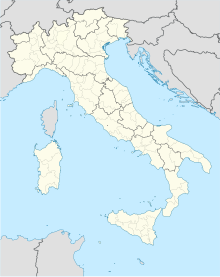
The Lupercal was a cave at the southwest foot of the Palatine Hill in Rome, located somewhere between the temple of Magna Mater and the Sant'Anastasia al Palatino. In the legend of the founding of Rome, Romulus and Remus were found there by the she-wolf who suckled them until they were rescued by the shepherd Faustulus. Luperci, the priests of Faunus, celebrated certain ceremonies of the Lupercalia at the cave, from the earliest days of the City until at least 494 AD.

Capri is an island located in the Tyrrhenian Sea off the Sorrento Peninsula, on the south side of the Gulf of Naples in the Campania region of Italy. The main town Capri that is located on the island shares the name. It has been a resort since the time of the Roman Republic.
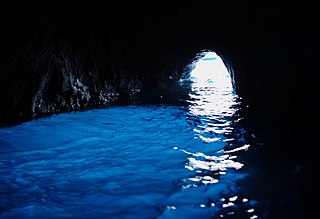
The Blue Grotto is a sea cave on the coast of the island of Capri, southern Italy. Sunlight passing through an underwater cavity and shining through the seawater creates a blue reflection that illuminates the cavern. The cave extends some 50 metres into the cliff at the surface, and is about 150 metres (490 ft) deep, with a sandy bottom.
A grotto is a natural or artificial cave used by humans in both modern times and antiquity, and historically or prehistorically. Naturally occurring grottoes are often small caves near water that are usually flooded or liable to flood at high tide. Sometimes, artificial grottoes are used as garden features. The Grotta Azzurra at Capri and the grotto at the villa of Tiberius in the Bay of Naples are examples of popular natural seashore grottoes.

Ponza is the largest island of the Italian Pontine Islands archipelago, located 33 km (21 mi) south of Cape Circeo in the Tyrrhenian Sea. It is also the name of the commune of the island, a part of the province of Latina in the Lazio region.

The Longmen Grottoes or Longmen Caves are some of the finest examples of Chinese Buddhist art. Housing tens of thousands of statues of Buddha and his disciples, they are located 12 kilometres (7.5 mi) south of present-day Luoyang in Henan province, China. The images, many once painted, were carved as outside rock reliefs and inside artificial caves excavated from the limestone cliffs of the Xiangshan (香山) and Longmenshan, running east and west. The Yi River flows northward between them and the area used to be called Yique. The alternative name of "Dragon's Gate Grottoes" derives from the resemblance of the two hills that check the flow of the Yi River to the typical "Chinese gate towers" that once marked the entrance to Luoyang from the south. There are as many as 100,000 statues within the 2,345 caves, ranging from 1 inch (25 mm) to 57 feet (17 m) in height. The area also contains nearly 2,500 stelae and inscriptions, hence the name “Forest of Ancient Stelae", as well as over sixty Buddhist pagodas. Situated in a scenic natural environment, the caves were dug from a 1 kilometre (0.62 mi) stretch of cliff running along both banks of the river. 30% date from the Northern Wei and 60% from the Tang dynasty, caves from other periods accounting for less than 10% of the total. Starting with the Northern Wei Dynasty in 493 AD, patrons and donors included emperors, Wu Zetian, members of the royal family, other rich families, generals, and religious groups.

Għar Dalam is a 144 metre long phreatic tube and cave, or cul-de-sac, located in the outskirts of Birżebbuġa, Malta. The cave contains the bone remains of animals that were stranded and subsequently became extinct in Malta at the end of the Last Glacial Maximum. It has lent its name to the Għar Dalam phase in Maltese prehistory, and is viewed as one of Malta's most important national monuments. Pottery similar to that found in Stentinello was found at Għar Dalam, but lacking details such as stamp decorations.
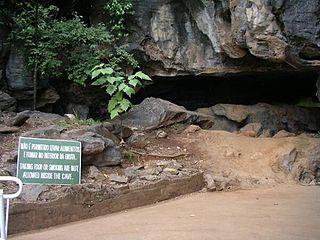
The Gruta Rei do Mato (MG-3653) is a cave located at the edge of the BR-040 highway, close to the off ramp to the city of Sete Lagoas, in Minas Gerais, Brazil. From Sete Lagoas the cave can easily be reached by bus, taxi or car. Sete Lagoas is 70 km (43.5 mi) from Belo Horizonte, the capital of the state.

Phong Nha-Kẻ Bàng is a national park and UNESCO World Heritage Site in the Bố Trạch and Minh Hóa districts of central Quảng Bình Province in the North Central Coast region of Vietnam, about 500 km south of Hanoi. The park borders the Hin Namno Nature Reserve in Khammouane Province, Laos to the west and 42 km east of the South China Sea from its borderline point. Phong Nha–Kẻ Bàng National Park is situated in a limestone zone of 2,000 km2 in Vietnamese territory and borders another limestone zone of 2,000 km2 of Hin Namno in Laotian territory. The core zone of this national park covers 857.54 km2 and a buffer zone of 1,954 km2.

A show cave — also called tourist cave, public cave, and in the United States, commercial cave — is a cave which has been made accessible to the public for guided visits.

The Jeita Grotto is a system of two separate, but interconnected, karstic limestone caves spanning an overall length of nearly 9 kilometres (5.6 mi). The caves are situated in the Nahr al-Kalb valley within the locality of Jeita, 18 kilometres (11 mi) north of the Lebanese capital Beirut. Though inhabited in prehistoric times, the lower cave was not rediscovered until 1836 by Reverend William Thomson; it can only be visited by boat since it channels an underground river that provides fresh drinking water to more than a million Lebanese.

Dorgali is a comune (municipality) in the Province of Nuoro in the Italian region Sardinia, located about 230 kilometres (140 mi) northeast of Cagliari and about 38 kilometres (24 mi) east of Nuoro in the Seaside Supramonte mountain area.

The grotto salamander, also called the Ozark blind salamander, is a species of salamander in the family Plethodontidae. It is now considered a member of the genus Eurycea, but was originally described as Typhlotriton speleus. It is endemic to the United States, specifically the karst regions beneath the Springfield and Salem Plateaus of the Ozark Mountains part of Arkansas, Kansas, Missouri, and Oklahoma. Its natural habitats are freshwater springs, inland karsts, and caves. It is not currently threatened, but vulnerable to changes in groundwater quality and reduction in bat population.
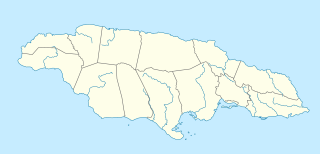
The Green Grotto Caves are show caves and a prominent tourist attraction on the north coast of Jamaica. Named for the green algae that cover its walls, the structure of the cave is strikingly different from inland systems; the cave is a Flank Margin Cave with two well-defined levels apparently indicating two periods with differing sea-levels. The innermost cavern contains a crystal-clear underground lake.
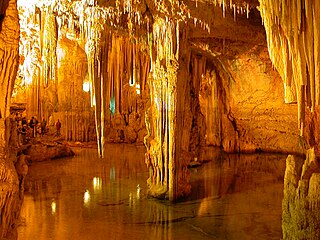
Neptune's Grotto is a stalactite cave near the town of Alghero on the island of Sardinia, Italy. The cave was discovered by local fishermen in the 18th century and has since developed into a popular tourist attraction. The grotto gets its name from the Roman god of the sea, Neptune.
Blue Grotto may refer to:
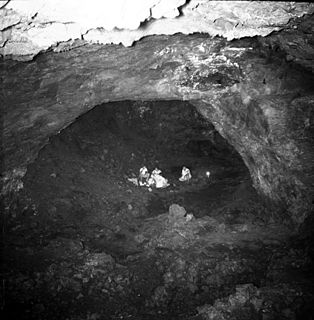
The Falemauga Caves are large natural caverns in a series of lava-tunnels situated in the Tuamasaga district along the central ridge of Upolu island in Samoa. The caves have been studied by archaeologists in Samoa with evidence of human occupation in pre-history. They were also used as a place of refuge by the people of Tuamasaga.
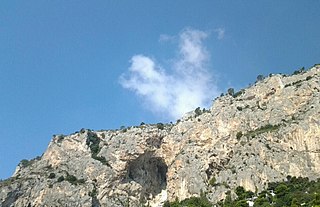
The Grotta delle Felci is a cave located on the island of Capri, in Campania, Italy.
Abisso di Malga Fossetta is a deep cavity of the plateau of the Sette Comuni, a complex of karst full of caves. The abyss is located in the municipality of Enego, in the province of Vicenza. The abyss of Malga Fossetta, with its currently known depth of more than 1,000 m, is the second deepest cavity in Veneto and one of the deepest in Italy.

